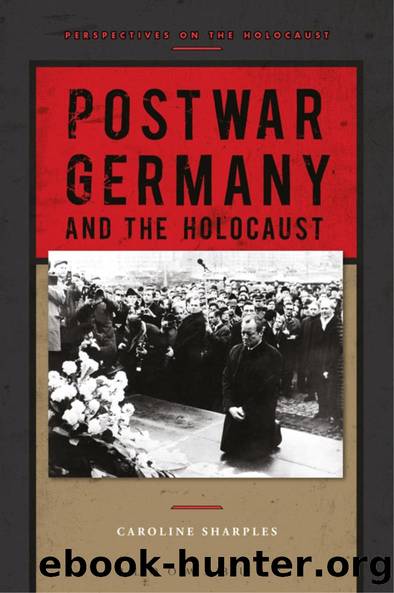Postwar Germany and the Holocaust by Caroline Sharples

Author:Caroline Sharples [Sharples, Caroline]
Language: eng
Format: epub
Tags: History, Holocaust, Europe, Germany, Modern, 20th Century, General
ISBN: 9781472512741
Google: RxomCwAAQBAJ
Publisher: Bloomsbury Publishing
Published: 2015-12-17T01:12:24+00:00
Reusing old memorials
So far, this chapter has focussed on those memorials that have been constructed specifically in response to the Holocaust or that have emerged from former Nazi sites. However, the meaning of memorials continues to evolve over time, with each generation viewing a monument in a different way, and changing political cultures affecting the preferred public narrative. In Berlin, the establishment of a national Holocaust memorial was accompanied by the reworking of an existing monument on Unter den Linden, one of the oldest thoroughfares in the cityâs centre. The Neue Wache was part of the old Prussian guardhouse and had been used for state ceremonies during the Kaiserreich. It glorified militarism and the Prussian tradition. After the First World War, the site became a memorial to fallen German soldiers and, from 1933, was appropriated by the Nazis to perpetuate heroic narratives of military sacrifice. After 1945, the Neue Wache became part of the Soviet sector of the city and was almost included in a general demolition of Prussian architecture that was taking place during the occupation period. In 1948, though, the memorial was reoriented as a monument to Soviet-German friendship. Statues of Prussian military heroes were removed and replaced with images of Communist leaders and tributes to Josef Stalin.59 From 1957, the site was dedicated as a Memorial to the Victims of Fascism and Militarism. The authorities, though, did more than simply swap political portraits around. References to the Holocaust were also â literally â embedded in the memorial as ashes from Buchenwald, Sachsenhausen and Ravensbrück were transferred to Berlin and buried in the Neue Wache.60
Following German reunification, the Neue Wache underwent yet another transformation. At the same time as Lea Rosh was campaigning for the construction of a central memorial to European Jewry, Chancellor Kohl decided that the new Germany also needed a central place in which dignitaries could pay their respects to the nationâs dead. To some extent, this decision showed that lessons had been learned after the unfortunate use of Bitburg during the fortieth anniversary commemorations of the warâs end in 1985. No other world leader would face the risk of visiting a cemetery containing SS graves when they wanted to demonstrate international friendship with Germany. The repositioning of the Neue Wache in this manner can be seen as representing the ânormalizationâ of German history after 1990. However, Kohlâs actions generated extensive public debate â the first post-unification expression of what Vergangenheitsbewältigung now meant for Germany.61
Controversy sprang from several issues including the siteâs rededication as a Memorial for Victims of War and Tyranny â a title that merged victims of both world wars together with those killed during the GDR â and the inclusion, at the centre of the memorial, of a sculpture by Käthe Kollwitz. This artwork depicted a mother mourning her dead child. It had been originally designed by Kollwitz in 1937 while coming to terms with the loss of her own son in the First World War. Critics noted that it had never
Download
This site does not store any files on its server. We only index and link to content provided by other sites. Please contact the content providers to delete copyright contents if any and email us, we'll remove relevant links or contents immediately.
Room 212 by Kate Stewart(5035)
The Crown by Robert Lacey(4723)
Endurance: Shackleton's Incredible Voyage by Alfred Lansing(4676)
The Iron Duke by The Iron Duke(4291)
The Rape of Nanking by Iris Chang(4137)
Joan of Arc by Mary Gordon(4013)
Killing England by Bill O'Reilly(3951)
Say Nothing by Patrick Radden Keefe(3903)
I'll Give You the Sun by Jandy Nelson(3357)
Shadow of Night by Deborah Harkness(3301)
Hitler's Monsters by Eric Kurlander(3268)
Mary, Queen of Scots, and the Murder of Lord Darnley by Alison Weir(3148)
Blood and Sand by Alex Von Tunzelmann(3138)
Darkest Hour by Anthony McCarten(3070)
Eleanor & Park by Rainbow Rowell(3063)
Margaret Thatcher: The Autobiography by Thatcher Margaret(3028)
Red Famine: Stalin's War on Ukraine by Anne Applebaum(2873)
Book of Life by Deborah Harkness(2867)
The One Memory of Flora Banks by Emily Barr(2803)
